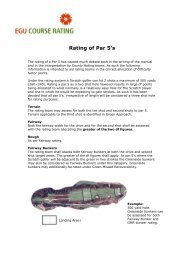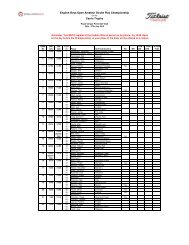Waste management - England Golf
Waste management - England Golf
Waste management - England Golf
You also want an ePaper? Increase the reach of your titles
YUMPU automatically turns print PDFs into web optimized ePapers that Google loves.
The Maintenance Facility:<br />
Best practice guide to the <strong>management</strong> of selected maintenance streams<br />
...Continued<br />
Engine breakdown is usually the fault of only<br />
one or two parts leaving the remainder in good<br />
working order.<br />
Many parts of a broken down engine can<br />
be salvaged for spares in other machines.<br />
Salvage merchants may pay for useable<br />
engine parts—look in the Yellow Pages for<br />
your nearest dealers.<br />
Repairing broken machinery is far more<br />
cost effective than buying new.<br />
When cleaning any oily machine parts,<br />
ensure run-off is treated as ‘special waste’<br />
and is passed through a water treatment<br />
area.<br />
Vehicle operating fluids (see also oil<br />
<strong>management</strong> section)<br />
This is one of the areas of greatest concern<br />
regarding motor vehicles. Although the<br />
disposal of fluids from ELVs is a major<br />
issue, the effects of inappropriate treatment<br />
of fluids removed during servicing are also<br />
significant.<br />
Much of the waste oil collected for recovery<br />
in the UK is processed (by removing<br />
excess water and filtering out particulates)<br />
and used as a fuel burnt in heavy industry<br />
and power stations. The preferred option<br />
for lubricating oils is re-refining for re-use<br />
as a base lubricant, although this doesn't<br />
currently occur on a large scale in the UK.<br />
<strong>Waste</strong> oil from nearly 3 million car oil<br />
changes in Britain is not collected. If<br />
collected properly, this could meet the<br />
annual energy needs of 1.5 million people.<br />
There are 1,500 oil recycling bins in Britain<br />
for lubricating oil only. Call the Oil Care<br />
Campaign on 0800 66 33 66 or use the<br />
post code search on their website<br />
www.oilbankline.org.uk to find the<br />
location of you nearest oil bank.<br />
Tyres<br />
See tyre <strong>management</strong> section.<br />
Batteries<br />
See batteries <strong>management</strong> section.<br />
Alternative fuels<br />
A number of machinery manufacturers are now taking their environmental responsibilities<br />
very seriously and pioneering the use of less environmentally damaging fuels.<br />
The main alternatives to traditional fossil fuels at the time of writing include bio-diesel, liquid<br />
petroleum gas (LPG) and electric motors.<br />
Bio-diesel is a fuel made from animal or vegetable fats which performs identically to petrol/<br />
diesel but produces less exhaust gases. It is also biodegradable and less damaging to the<br />
environment if spilt.<br />
LPG is one of the fastest growing commercial fuels in the UK. It is a by-product of North<br />
Sea oil production and is a mixture of butane and propane. Almost any vehicle can be<br />
converted to run on LPG and many cars, vans and maintenance machines are now<br />
constructed with the option of LPG. Its use within an engine gives no discernible<br />
difference to traditional fuels and emits up to 99.8% less pollutants.<br />
Electric motors have come a long way over the past few years with ‘hybrid’ cars now<br />
becoming commonplace on our roads. The use of an electrically powered mower or golf<br />
cart may at first seem environmentally sound but we must consider how the energy is<br />
produced in the first instance. If the machine is charged up from mains electricity then we<br />
are simply moving the pollution to a different source (i.e. the power station). Far more<br />
desirable than this is the use of small scale generators in-house. Wind turbines and solar<br />
panels are now available commercially and the technology is now becoming such that<br />
they are economically viable.<br />
Engine emissions<br />
During the combustion process, internal combustion engines of all types generally produce,<br />
in varying quantities, the following substances:<br />
Oxides of nitrogen (NOx), a contributor to photochemical smog and to ozone layer<br />
damage<br />
Carbon monoxide (CO), a toxic gas (harmful to humans, animals and plants)<br />
Carbon dioxide (CO 2 ), the most significant cumulative 'greenhouse gas'<br />
Hydrocarbons (HC), a constituent of photochemical smog<br />
Sulphur dioxide (SO 2 ), an element in acid rain formation<br />
Lead (Pb), a toxic heavy metal<br />
Particulate matter, a potential carcinogen and inhibitor of photosynthesis in plants.<br />
Water (H 2 0), an important contributor to the ‘greenhouse effect<br />
Types of engines<br />
The vast majority of maintenance machinery use one of the following engine types:<br />
2 stroke engine fuelled by a petrol/oil mix or converted to propane<br />
4 stroke engine fuelled by petrol, diesel or propane<br />
4 stroke engines generally produce higher CO, CO 2 , and NOx, but lower HC than 2 stroke<br />
engines. Two stroke engines emit relatively high levels of HC in both burnt and unburned<br />
form, but low levels of NOx. Diesel engines are more fuel efficient than 4 stroke or 2 stroke<br />
petrol engines and therefore emit lower overall CO and CO 2 . However, they produce greater<br />
quantities of SO 2 , nitrogen dioxide and particulates.<br />
WASTE MANAGEMENT<br />
Best Practice Approach for English and Welsh <strong>Golf</strong> Clubs<br />
36

















